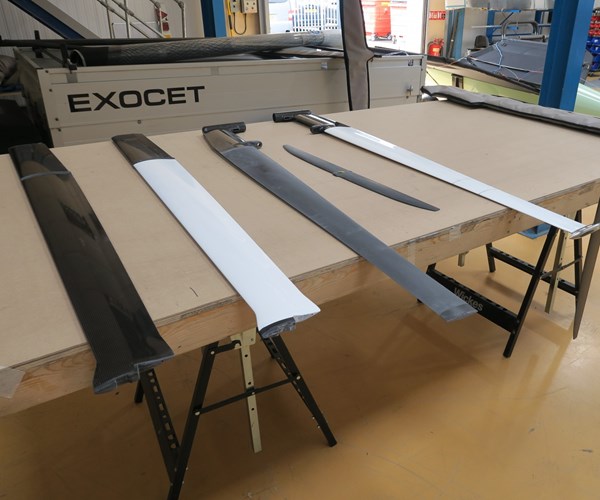This foiling racer is crazy fast thanks to composites
The Exocet racer’s hull and its foils, designed via computer model, are fabricated using hand layup and resin infusion methods, respectively, with PRO-SET epoxy.
I found in my inbox last week a picture like this one illustrating a blog by Jake Kavanagh (May 24, 2018) in the Epoxycraft newsletter —Epoxycraft is published by West System International (Romsey, UK), the maker of well-known marine epoxies WEST SYSTEM and PRO-SET under license from Gougeon Brothers Inc., now known as West System Inc. (Bay City, MI, US). The blog described the Exocet racer (Moth class) built by Maguire Boats (New Milton, Hampshire, UK) and it spurred me to do some research on how it is possible to do what the guy in the picture is doing.
First, what is a Moth? It refers to a class of small single-handed dinghys that first appeared in Australia in the late 1920s and in the US in 1930. The name “Moth” was coined by the American group, and Moth Class racing began later in the 1930s. An International Moth Class boat is 3.4m in length with unrestricted hull weight. So why is this small boat 6 feet above the surface of the water? It is, of course, supported by foils, or small wing-shaped structures at the ends of long tubular supports that attach to the hull. The foils create lift as the boat speed increases and lift the hull out of the water; the wetted area of the craft is radically reduced and boat speed is significantly increased.
Moths have been foiling since the 1970s, according to the International Moth Class Assn. UK web site — and did you know that foils were first invented by Alexander Graham Bell, working with Italian inventor Enrico Forlanini in the early 1900s? (Epoxycraft’s September 30, 2016 blog explains the history of foil development). In fact, according to some sources, the fast speeds achieved by foiling Moths was the inspiration for the most recent America’s Cup Class hydrofoiling yachts.
So the concept is more than 100 years old, but the technology for achieving 30 knots (55 km/hour) as described in Kavanagh’s blog is exemplified by Maguire Boats. The company, says the blog, has worked closely with designer Kevin Ellway for over five years since the introduction of the Exocet. This close partnership has enabled Maguire to continually improve a boat that has won the last three Moth World Championships as well as multiple European and National titles, including the 17 top positions at the Moth Worlds in Bermuda, earlier this year.

Foils for the Exocet are made in an infusion process using PRO-SET epoxy and ultra high modulus carbon cloth.
Kavanagh’s blog says that the Exocet hull and its foils, designed via computer model, are fabricated using hand layup and resin infusion methods, respectively, with PRO-SET epoxy. Maguire Boats’ managing director Simon Maguire says that his team first visited West System’s research lab to learn about effective infusion processes, ones that have resulted in parts with very high strength-to-weight ratio. For example, the hull components are a sandwich of ultra-high modulus (UHM) carbon fiber skins over a very thin foam core. With PRO-SET LAM 125 epoxy resin with LAM 226 hardener, the resulting hull section weighs just 10kg, says Maguire. The foils are infused in solid aluminum molds using PRO-SET infusion epoxy INF 114/210/211 with UHM carbon cloth, says the blog.
Maguire’s production rate is 24 boats a year, built in batches of four, according to Kavanagh’s blog. Maguire says “If we start making more than that, there is a risk to the quality. We pride ourselves on the consistency of the finish and performance of each boat, which makes them so sought after. Quality is everything – and as the results show, it wins races.” Read the entire Kavanagh blog here: and learn more about the history of foiling watercraft here: .
Related Content
Revisiting the OceanGate Titan disaster
A year has passed since the tragic loss of the Titan submersible that claimed the lives of five people. What lessons have been learned from the disaster?
Read MoreAl Seer Marine, Abu Dhabi Maritime unveil world’s largest 3D-printed boat
Holding the new Guinness World Record at 11.98 meters, the 3D-printed composite water taxi used a CEAD Flexbot to print two hulls in less than 12 days.
Read MoreRecycled carbon fiber composite panels power 40% lighter, durable semi-rigid solar panels
Designed for auxiliary power use while traveling via boat or RV, Italian startup Levante’s custom flexible or standardized semi-rigid solar panels combine the benefits of ReCarbon’s rCF and thermoplastics.
Read MoreCEAD launches the Maritime Application Center dedicated to industrial 3D printing boat hulls
The MAC is an LFAM-powered production facility equipped with highly automated, digitally driven manufacturing processes and built around a collaborative model to develop the boats of the future.
Read MoreRead Next
Cutting 100 pounds, certification time for the X-59 nose cone
Swift Engineering used HyperX software to remove 100 pounds from 38-foot graphite/epoxy cored nose cone for X-59 supersonic aircraft.
Read MoreCeramic matrix composites: Faster, cheaper, higher temperature
New players proliferate, increasing CMC materials and manufacturing capacity, novel processes and automation to meet demand for higher part volumes and performance.
Read MoreScaling up, optimizing the flax fiber composite camper
Greenlander’s Sherpa RV cab, which is largely constructed from flax fiber/bio-epoxy sandwich panels, nears commercial production readiness and next-generation scale-up.
Read More












